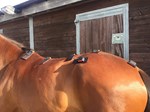Search - Veterinary Services
231 - 240 of 262 results
-
Article
Successful Feline Infectious Peritonitis Treatment with Remdesivir
Merlin, a 24-week-old male neutered Bengal cat, was referred to the Queen Mother Hospital for Animals (QMHA) with a one-week history of lethargy, hyporexia and a 24-hour history of tachypnoea. He was the first of more than a dozen cats with … -
Article
Pain(T) In the Neck – Computed Tomography Myelography of the Cervical Spine
Maty Looijen, Equine Resident Clinical problems associated with the cervical spine in horses are common. They involve a wide variety of symptoms, including neurological deficits (e.g. ataxia, dysmetria, paresis), neck pain and stiffness, and gait … -
Article
Risk Factors for Dacryocystitis in Pet Rabbits
Joanna Hedley, Victoria Ede and Charlotte Dawson Dacryocystitis is relatively common in pet rabbits and is often present concurrently with other diseases. However, there are relatively few studies reporting the prevalence of ocular disease – and … -
Article
Developments in Forensic Pathology
Seven years ago the RVC appointed Henny Martineau as Head of Forensic Pathology, to lead the discipline at the RVC. The team has worked on a number of prominent cases in recent years. The so-called ‘Croydon cat killer’ was one such case. The RVC … -
Specialist Service in Surgical Oncology
Surgery is a vital part of care for many dogs and cats with cancer, because it is the most effective option for the management of most cancer cases. The goal of surgical oncology is to eliminate cancer cells from the body and to prevent the spread … -
Article
A Decade of Extracorporeal Therapy
It is ten years since the RVC began delivering extracorporeal therapies for cats and dogs with kidney injury, immune-mediated disease and certain toxicities. More than 50 patients have received the advanced treatments, most of which would have died without it. -
RVC breakthrough reveals the molecular mechanisms that underlie a form of ‘tying up’ in horses
Breakthrough at Royal Veterinary College as researchers reveal the molecular mechanisms that underlie a common genetic form of ‘tying up’ in horses -
Sensor technology allows experts to enhance understanding of the relationship between lameness and back problems in horses
Sensor technology is allowing experts from the RVC and Animal Health Trust to enhance their understanding of the relationship between lameness and back problems in horses -
Weight gain more than doubles the risk of laminitis in horses and ponies
Horses and ponies that gain weight are more than twice as likely to develop laminitis than if they lose or maintain their weight, new research has found. -
Tumour Specific Electroporation at RVC Equine
TSE is dynamic electroporation technology used treating equine tumours that are not easily removed with surgery and also treating equid sarcoids



